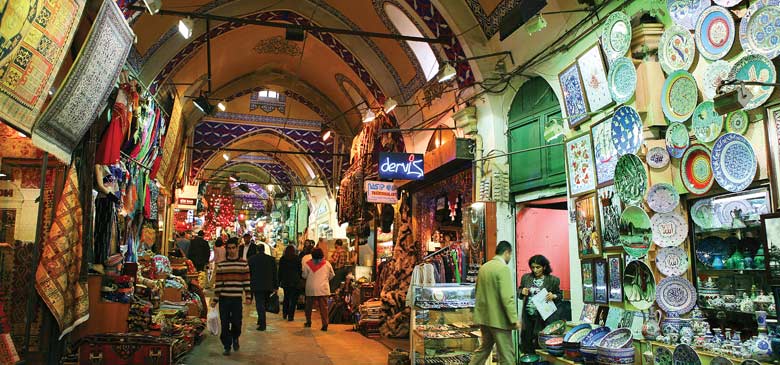
Population size: 74.7 million
Area: 783,562km2
% growth in 2011: 8.5
Type of govt: Parliamentary republic
Official language: Turkish
Capital city: Ankara
Largest city: Istanbul
GDP (PPP): $1.073 trillion
Central govt debt as a proportion of GDP: 40%
Currency: Turkish lira (TRY)
Currency rate against the pound: 2.83
Turkey is one of the fastest-growing economies in the world thanks to its youthful demographic profile. Some 27% of the Turkish population is younger than 15, compared with 17% in the UK and 13% in Germany. With a burgeoning market of young customers eager to buy goods and services, there is huge potential in Turkey for key sectors such as banking, telecoms, autos, consumer durables and construction.
The per capita household income is only $10,000, which makes it hard for households to save. The Turkish like to spend, however, which has resulted in the country building up a high current account deficit that is 10% of GDP. Fuel is the primary import item, but it also imports chemicals, machinery and semi-finished goods that are used in the production of exports (which are generally very low value added). Cars, electrical appliances, textile products, chemicals and steel are Turkey’s primary exports. The country’s export-to-import ratio (the value of products exported compared with the value of products imported) is just 56%, making it a net importer.
In order to encourage the private sector to produce more of the essential products that are imported, and to promote the manufacture of higher value-added goods, the Turkish government recently introduced an investment incentive scheme. The incentive zones are grouped into six regions to attract investment to underdeveloped areas. Incentives will be highest for projects that start before the end of 2012 and will be gradually reduced over the coming years. Attractive aspects of the scheme for strategically important sectors, such as steel, chemicals, machinery and automotive, include:
While Turkey’s high current account deficit theoretically keeps its currency fragile, the Central Bank of Turkey (CBT) uses unorthodox policies to minimise exchange rate volatility. The CBT has a very flexible interest rate policy that is adjusted on a daily basis. At times of potential capital outflows, the CBT increases short-term rates by providing less liquidity at the very low 5.75% interest rate. Banks are therefore forced to undertake short-term borrowing at rates closer to 11%.
This strategy attracts ‘hot money’ (funds from investors actively seeking high short-term returns) and helps to prevent the depreciation of the TRY. The CBT has used this approach more and more frequently to battle inflation – the prices of imported products fall as TRY appreciates, reducing inflation. But currency appreciation is a double-edged sword since a strong TRY encourages imports and does not help to shrink the country’s current account deficit.
Banking penetration in Turkey is among the lowest in the world. The mortgage-to-GDP ratio (ratio of outstanding home loans to GDP) is only 7%, compared with 72% for the UK and 39% for Germany, but year-on-year ratio growth was 28% for 2011, making Turkey the fastest-growing market for mortgages in the world. And it’s not only mortgages – all types of consumer loans are becoming more popular. So much so, that the government sees the growth in loans as the primary factor behind the country’s widening current account deficit. It tried to limit annual loan growth to 25% in 2011 and managed to slow it down to 30%. The limit for 2012 is 15%, which is likely to be achieved.
Turkish banks are very well capitalised. They typically have eight times leverage in terms of their lending-to-equity ratio and a 16% total capital adequacy ratio, almost all of which is tier 1 (core capital). From July, the risk weighting on the government’s foreign currency debt instruments will be increased from 0% to 100% to comply with Basel II regulation, as Turkey’s sovereign rating is still below investment grade. While Basel II is likely to reduce the banks’ capital adequacy ratios by around 150bp, they will still be more comfortably off than their peers in other countries. As the growth of risk-weighted assets held by Turkish banks is set to remain below the country’s long-term return on equity expectation, capitalisation problems seem unlikely for the foreseeable future.
Basel III, meanwhile, is a non-issue for Turkish banks since they have few minority interests in subsidiaries and are already compliant with liquidity regulations thanks to the rigid policies of the Turkish banking watchdog.
Turkish banks rely heavily on deposits for their funding, but these are scarce due to the country’s relatively low per capita income. Loan-to-deposit ratios scaled the heights of 100% in May 2012, prompting banks to tap other funding sources such as bond issuances. Now, issued bonds make up 2% of the balance sheets (compared with nothing at the end of 2010), which amounts to some $11bn in additional funding. Turkish banks are likely to continue to issue long-term eurobonds and shorter-term local currency-denominated bonds in 2012.
Mete Yüksel is head of research at TEB Investment, a joint venture with BNP Paribas Corporate & Investment Banking.
